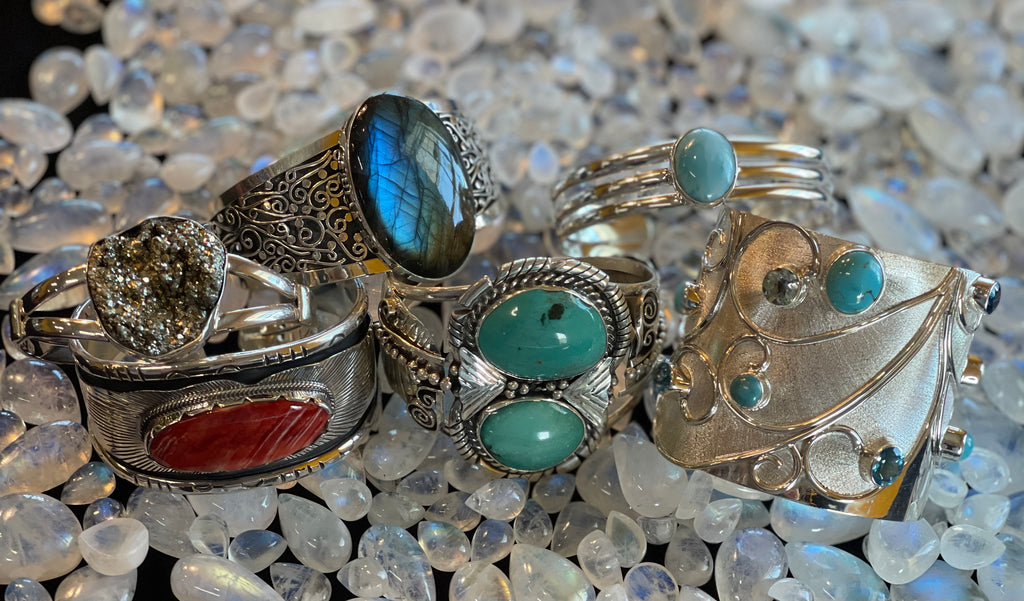Discover Myths and Legends about Your Favorite Gemstones

Discover Myths and Legends about Your Favorite Gemstones
For thousands of years, humans have relied on various types of objects for their inherent spiritual properties or the deep meanings imbued in their history and lore. Many of the gemstones and minerals that we wear today were also favorites of the ancients who ascribed many different traits and stories to them. These stories, myths, and legends continue to resonate with wearers, and you may find that you gravitate to certain gems more than others for more than just their attractive color or shape. After learning about the ancient lore of the following gemstones, you might be more drawn to them than ever.
Amber
Dubbed ‘Baltic gold,’ amber has been revered, according to historians, since roughly 8,000 BC when it carved amber pendants and amulets were found buried at gravesites. In fact, Baltic amber hunters still search for these golden nuggets in the shallows of the Baltic Sea where it’s still found. Not only was the stone treasured among prehistoric peoples, but it is still popularly worn today. The Greeks believed amber was “made by the sun,” and many other cultures also loved the stone for its bright yellow-orange glow. Though technically not a mineral or gemstone, amber is actually fossilized tree resin. Though much of the tree resin from primordial forests would have decayed, some deposits that were buried fossilized and, ultimately, transformed into the beautiful golden-hued substance we know today as amber.
Many cultures, like the Greeks, associated amber with sun gods and, so, wore amber as a means to garner divine protection. In many parts of Europe, parents adorned their teething babies with amber necklaces thought to ease the pain of cutting teeth. Women also believed that wearing amber could boost their fertility. Perhaps the most popular story of amber comes from today. In the film Jurassic Park, scientists believe that DNA trapped in amber could allow them to bring dinosaurs back to life. Myths and lore aside, amber continues to be fashioned into necklaces, earrings, rings, and other jewels that both men and women wear today.
Amethyst
A variety of purple quartz, amethyst has been prized by people for thousands of years. This beautiful purple gem has been fashioned into the jewels of royals and was once as costly as rubies and emeralds. However, thanks to large deposits found in South America, good-quality amethyst is now much easier to purchase--and less expensive than it used to be.
Amethyst is the traditional birthstone for the month of February, but before it was associated as such, it was worn by ancient Greeks to help protect them from the effects of intoxication. That belief persisted for centuries and soldiers associated with various Mediterranean cultures wore amulets of amethyst in the belief that it would keep them level-headed, calm, and cool in battle.
In one more recent myth told by a Renaissance poet, the stone amethyst derived from a chaste maiden who was pursued by Bacchus, the Roman god of wine. The goddess Diana granted the maiden’s prayer for help, turning her into a stone. Beautiful amethyst is, today, featured in many jewels. Artisans may carve it to create higher end pieces. The gem is popularly worn as earrings, bracelets, rings, and pendants.
Labradorite
A member of the feldspar family of minerals, labradorite boasts an attractive iridescent effect that has long made it popular with wearers. Named for deposits of the mineral found near Labrador, Canada, labradorite is also found in other parts of the world such as Norway, China, and Australia. The Innuit people once believed that labradorite fell from the Aurora Borealis and, so, contained magical properties. Shaman and healers favored the stone for its mystical properties, particularly for its ability to endow the wearer with ‘physic’ properties.
Shimmering with blue, violet, and silvery hues, labradorite can be featured in many different jewels such as pendants and earrings. It’s also made into beads. Some people continue to believe this mineral enhances a person’s intuitiveness and can facilitate deep reflection. Others wear it in the belief that it contributes to mental health. Because of its association with the Northern Lights, many people also wear this mineral as a winter gem.
Lapis Lazuli
The deep marine blue hues of lapis lazuli have been prized for thousands of years. According to historians, the stone has been mined since at least the 7570 BCE. Lapis beads and pendants have been found in Neolithic graves as well as the funeral masks of Egyptian pharaohs like Tutankhamun. Major sources of lapis hail from Afghanistan as well as the region around Lake Baikal in the Siberian region of Russia.
A mineral particularly known for its ancient prestige, lapis lazuli jewelry was popularly used for jewelry and seals in civilizations the Akkadians, Sumerians, Babylonians, Mycenaians, and Egyptians. It’s said that Cleopatra had lapis ground into her eye shadow. Early Christians associated lapis with the Virgin Mary.
In one of the earliest myths regarding lapis dates to the Sumerian Civilization. Its people believed that the goddess Inanna was wearing a necklace of lapis lazuli during her departure to and return from the underworld. This ancient stone is worn today in a wide range of jewelry. The deeper the blue, the better quality the mineral. Lapis can also be flecked or streaked with gold, which makes it a lovely accompaniment to gold settings.
Larimar
Unlike several of the gemstones and minerals here with a truly ancient history, larimar was only discovered briefly in 1916, but attempts to mine it in the Dominican Republic were squashed. It wasn’t rediscovered until 1974. It is only found in the Dominican Republic where it is known as “blue stone.” It’s discovered named it for his daughter Larissa and the Spanish word for sea--mar.
Larimar is a pectolite mineral that’s noted for its pale, almost translucent blue hues. These gemstones are primarily found in pectolite sediments washed down the Bahoruco River and deposited in the sea and along beach gravel. Beautiful but rare, larimar was thought by some, most famously the psychic Edgar Cayce, to have washed up from the lost civilization of Atlantis. Some believe that the stone contains healing properties.
Larimar is mainly paired with silver jewelry, but can sometimes be found set in gold. The bluer the stone, the more rare it is and, for that reason, the more expensive. Larimar is sometimes found in green but its blue hue is especially popular among its fans.
Moonstone
With its luminous quality, moonstone has long been associated with the celestial body it’s named for. Part of the feldspar family of minerals, moonstone feature opalescent hues that fairly gleam on its pearly surface. Both the ancient Greeks and Romans revered the stone and believed that it harbored moonlight or moon rays. Various cultures where the stone is found wore it as an amulet for protection or to promote fertility.
In India, moonstone is particularly sought after. Gem merchants showcase the stone on yellow cloth to denote its sacred nature. In India and elsewhere, moonstone is regarded as a stone of good luck. In recent centuries, sailors would wear moonstone to protect them at sea because it was known that the moon influenced the tides. It’s said that when lovers quarrel, they should give each other a moonstone jewel to restore tranquility to their relationship.
Today, moonstone is found in many locations across the world, including Norway, Myanmar, Armenia, Mexico, Australia, and Switzerland. The stone is used to create many different jewels including charms, beads, earrings, pendants, and more. Moonstone is sometimes carved as well. The famous jeweler Rene Lalique is renowned for his moonstone jewelry he produced during the Art Nouveau period.
Turquoise
As one of the world’s most ancient gemstones, turquoise is widely recognized for his blue-green shades and versatile designs. This mineral was prized in both the Old World and the New World among many civilizations. Chinese artisans have been carving turquoise for jewelry for more than 3,000 years. Turquoise was featured in the jewels of Egyptian royalty as well as in amulets and beads worn by Native Americans like the Apache of the Southwestern U.S.
The Aztecs were especially fond of turquoise. They valued the mineral more than gold and emeralds, according to the conquistadors that met with them. Some tribes like the Navajo believed that turquoise had the power to summon rain. Apache hunters believed that turquoise could improve their hunting skill. Today, many people associate turquoise with positivity and wear the stone to promote positive energy. Turquoise jewelry is widely popular in many styles, including earrings, rings, and pendants.
While many people choose gemstones to wear simply because of their beauty, it’s often interesting to discover that the world’s most beautiful and highly sought after gemstones have another dimension that only adds to their appeal. Many people continue to revere the old myths and legends that surround these and other gems. Even if you don’t believe in the more mystical attributes these gems are said to possess, you might still find their histories fascinating and something worth keeping in mind as you shop for new jewelry.

Leave a comment